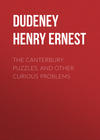Kitabı oku: «The Canterbury Puzzles, and Other Curious Problems», sayfa 15
108.—Plato and the Nines
The following is the simple solution of the three nines puzzle:—
9 + 9
——
.9
To divide 18 by .9 (or nine-tenths) we, of course, multiply by 10 and divide by 9. The result is 20, as required.
109.—Noughts and Crosses
The solution is as follows: Between two players who thoroughly understand the play every game should be drawn. Neither player could ever win except through the blundering of his opponent. If Nought (the first player) takes the centre, Cross must take a corner, or Nought may beat him with certainty. If Nought takes a corner on his first play, Cross must take the centre at once, or again be beaten with certainty. If Nought leads with a side, both players must be very careful to prevent a loss, as there are numerous pitfalls. But Nought may safely lead anything and secure a draw, and he can only win through Cross's blunders.
110.—Ovid's Game
The solution here is: The first player can always win, provided he plays to the centre on his first move. But a good variation of the game is to bar the centre for the first move of the first player. In that case the second player should take the centre at once. This should always end in a draw, but to ensure it the first player must play to two adjoining corners (such as 1 and 3) on his first and second moves. The game then requires great care on both sides.
111.—The Farmer's Oxen
Sir Isaac Newton has shown us, in his Universal Arithmetic, that we may divide the bullocks in each case in two parts—one part to eat the increase, and the other the accumulated grass. The first will vary directly as the size of the field, and will not depend on the time; the second part will also vary directly as the size of the field, and in addition inversely with the time. We find from the farmer's statements that 6 bullocks keep down the growth in a 10-acre field, and 6 bullocks eat the grass on 10 acres in 16 weeks. Therefore, if 6 bullocks keep down the growth on 10 acres, 24 will keep down the growth on 40 acres.
Again, we find that if 6 bullocks eat the accumulated grass on 10 acres in 16 weeks, then

Add the two results together (24 + 64), and we find that 88 oxen may be fed on a 40-acre meadow for 6 weeks, the grass growing regularly all the time.
112.—The Great Grangemoor Mystery
We were told that the bullet that killed Mr. Stanton Mowbray struck the very centre of the clock face and instantly welded together the hour, minute, and second hands, so that all revolved in one piece. The puzzle was to tell from the fixed relative positions of the three hands the exact time when the pistol was fired.
We were also told, and the illustration of the clock face bore out the statement, that the hour and minute hands were exactly twenty divisions apart, "the third of the circumference of the dial." Now, there are eleven times in twelve hours when the hour hand is exactly twenty divisions ahead of the minute hand, and eleven times when the minute hand is exactly twenty divisions ahead of the hour hand. The illustration showed that we had only to consider the former case. If we start at four o'clock, and keep on adding 1 h. 5 m. 27-3/11 sec., we shall get all these eleven times, the last being 2 h. 54 min. 32-8/11 sec. Another addition brings us back to four o'clock. If we now examine the clock face, we shall find that the seconds hand is nearly twenty-two divisions behind the minute hand, and if we look at all our eleven times we shall find that only in the last case given above is the seconds hand at this distance. Therefore the shot must have been fired at 2 h. 54 min. 32-8/11 sec. exactly, or, put the other way, at 5 min. 27-3/11 sec. to three o'clock. This is the correct and only possible answer to the puzzle.
113.—Cutting a Wood Block
Though the cubic contents are sufficient for twenty-five pieces, only twenty-four can actually be cut from the block. First reduce the length of the block by half an inch. The smaller piece cut off constitutes the portion that cannot be used. Cut the larger piece into three slabs, each one and a quarter inch thick, and it will be found that eight blocks may easily be cut out of each slab without any further waste.
114.—The Tramps and the Biscuits
The smallest number of biscuits must have been 1021, from which it is evident that they were of that miniature description that finds favour in the nursery. The general solution is that for n men the number must be m (nn+1) – (n – 1), where m is any integer. Each man will receive m (n – 1)n – 1 biscuits at the final division, though in the case of two men, when m = 1, the final distribution only benefits the dog. Of course, in every case each man steals an nth of the number of biscuits, after giving the odd one to the dog.
